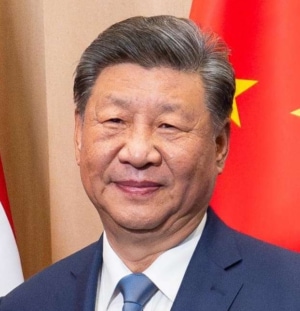Under the leadership of Xi Jinping, China continues to uphold the “One China” principle, viewing Taiwan as an inseparable part of its territory. The drive for unification burns stronger than ever.
Large-scale military exercises in the Taiwan Strait, the rapid modernization of China’s armed forces, and intensified cyberattacks and disinformation campaigns—so-called “cognitive warfare”—all point to military invasion plans should peaceful unification fail.
According to multiple military analyses, China aims to establish by 2027 a military posture capable of deterring U.S. intervention, seeking to seize control of Taiwan through a rapid short-term campaign.
Tensions in the Taiwan Strait have reached critical levels, increasingly threatening global stability.
Taiwan Unification: A Personal Mission for Xi Jinping

Xi Jinping CC BY 3.0
China’s strategy is layered and calculated. First, it exerts diplomatic pressure and economic influence to further isolate Taiwan on the international stage.
In January 2024, Taiwan’s diplomatic setbacks continued with Nauru severing ties, leaving Taiwan with only 12 official allies.
At the same time, China has expanded its cognitive warfare operations, leveraging cyberattacks and disinformation campaigns to sow division and destabilize public opinion within Taiwan.
These efforts are part of China’s broader “gray zone” strategy—an attempt to capture Taiwan without firing a shot.
However, according to sources close to the authorities, if non-military means fail, China is preparing a rapid short-term invasion scenario, aiming to suppress any U.S. intervention by 2027.
The plan reportedly envisions seizing Taiwan within approximately one week.
The People’s Liberation Army (PLA) continues large-scale amphibious assault exercises, while accelerating the deployment of precision-guided munitions enhanced by satellite and AI technologies.
China’s strategic planning revolves around one core factor: U.S. response capability.
According to the U.S. Department of Defense’s 2023 report, China has organized six amphibious combined arms brigades, with four assigned to the Eastern Theater Command for potential Taiwan operations.
In response, the U.S. military has strengthened joint exercises in northern Philippines and increased arms sales to Taiwan to bolster deterrence.
Yet military analyses concerning the Taiwan Strait suggest that China’s utilization of the Strait’s shallow waters and its own satellite navigation system could neutralize U.S. carrier strike groups, casting doubt on the effectiveness of U.S. intervention.
Moreover, China’s growing arsenal of hypersonic missiles and unmanned aerial vehicles poses a serious threat to U.S. air defenses, potentially altering the course of any conflict.
It’s No Longer a Question of If, but When

Taiwan President Lai Ching-te Public Domain
China’s official military budget for 2024 is approximately 1.66554 trillion yuan—about 17 times that of Taiwan—and the real gap is likely even wider.
Observers note that Xi Jinping may exploit potential weaknesses in U.S. or Japanese leadership, particularly targeting the period up to 2025, depending on the outcomes of upcoming elections.
China is also strengthening ties with Russia and North Korea, exploring multi-front strategies to stretch U.S. military resources.
One plausible scenario involves China simultaneously provoking incidents in the South China Sea and near the Senkaku Islands, thereby dispersing U.S. military forces.
Such moves would test not only U.S. rapid response capabilities but also the cohesion of its alliances.
If peaceful unification collapses and military invasion becomes unavoidable, the situation could escalate into a serious regional—and global—crisis.
The PLA is reportedly deploying hypersonic missiles, stealth drones, and electromagnetic pulse weapons in the Eastern Theater Command, enhancing its ability to swiftly neutralize Taiwan’s air defenses and command systems.
Beijing appears prepared to endure international sanctions and retaliation, confident in achieving a quick victory through a short-term campaign.
A Taiwan conflict would not merely be a regional issue—it would ignite a major confrontation between the U.S. and China, wreaking havoc on global supply chains and energy markets.
The clock is ticking, and the rising tensions in the Taiwan Strait are pushing the world closer to a critical tipping point.
The international community watches with bated breath, trying to discern China’s next move.


